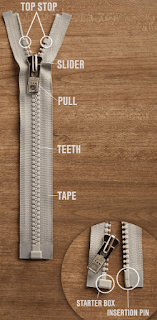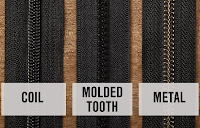In the realm of garment construction and DIY fashion, two essential elements stand out as primary fastening devices: zippers and buttons. These small yet significant components play a crucial role in adding functionality and style to our clothing. In this article, we'll delve into the art of sewing zippers and buttons, exploring techniques, tips, and tricks to help you confidently incorporate these fasteners into your sewing projects.
Mastering the Art of Fastening: A Guide to Sewing Zippers Anatomy and Buttons
Zippers come in various types, including conventional coil zippers, metal zippers, and invisible zippers. Each type serves a specific purpose, from adding a decorative touch to seamlessly blending into fabric.
- Centered Zipper: Ideal for dresses and skirts, this method involves sewing the zipper along the center-back or center-front seam.
- Lapped Zipper: Common in tailored garments, a lapped zipper is partially concealed by folding fabric edges over the zipper teeth.
- Invisible Zipper: This type is installed with the zipper teeth hidden behind the fabric, providing a seamless look often found in formalwear.
- Always interface the fabric to provide stability.
- Ensure the zipper length matches the garment opening, and if necessary, trim it accordingly.
- Baste the zipper in place before machine stitching for precision.
- Use a zipper foot for accuracy.
- Start and stop stitching about an inch away from the zipper pull for ease of opening and closing.
- Secure the zipper ends with backstitches or bar tacks.
Select buttons that complement your fabric and garment style.
Consider button size, shape, and color to achieve the desired aesthetic.
Accurate buttonhole placement is crucial for a functional garment.
Measure and mark buttonhole positions based on your pattern or design.
Use the appropriate buttonhole foot on your sewing machine.
Test buttonholes on a fabric scrap to ensure the machine settings are correct.
Hand-sew buttons securely using a strong thread.
For shank buttons, create a thread shank to allow room for fabric layers when the button is fastened.
Use buttons as embellishments for added style.
Experiment with different button arrangements to create unique and eye-catching designs.
Mastering the art of sewing zippers and buttons opens up a world of creative possibilities in garment construction and customization. Whether you're adding a sleek zipper to a tailored dress or incorporating decorative buttons on a blouse, understanding the techniques and practicing precision will elevate the quality of your sewing projects. So, grab your fabric, sewing machine, and a variety of zippers and buttons, and embark on a journey of fastening mastery in the world of sewing.
Contact Info
Office : Jalan Sri Gunting 1/37 Burangkeng, Setu, Kabupaten Jawa Barat, Indonesia
Contact List
WhatsApp: +62838 1516 3168
Instagram.com/bimaher
Facebook.com/bimaher
Created By Bimaher @2024 | Copyright Bimaher@2024


